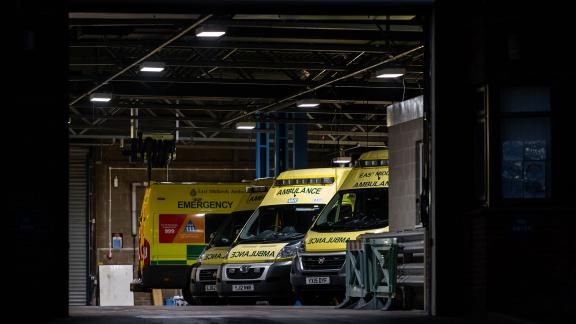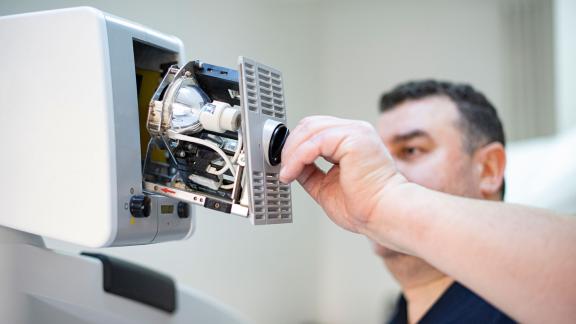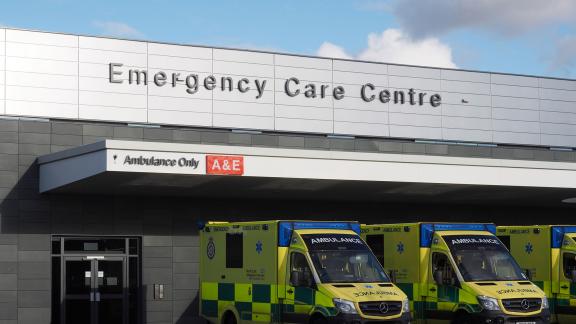Unlocking productivity through the ambulance estate
Key points
The ambulance estate in England has a growing maintenance backlog which has reached over £146 million, including a rapidly increasing proportion of high-risk repairs.
Although transformation is being impeded due to a lack of capital funding across the NHS, some trusts are succeeding in improving their services. This is above all where strong relationships are maintained with integrated care boards with which they are coterminous.
Poor facilities are increasing running costs, endangering staff, blocking progress to net zero, and impeding the shift to an electric ambulance fleet.
Significant productivity gains can be achieved by investing in the ambulance estate, including steps such as adopting the ‘make ready’ model set out in the Carter review and pursuing co-location.
This briefing sets out the current condition of ambulance trusts’ estates. It explains the role that improved support and control facilities can play in increasing the ambulance service’s productivity and highlights some key areas of best practice already apparent in England and Wales.
It will be of interest to those within systems and ambulance trusts alike who are seeking to upgrade their own facilities, as well as anyone who is eager to better understand the chief enablers of better productivity within the sector and some of the barriers to change which can exist. It has been drawn together following discussions with leaders across England and Wales, all of whom are currently responsible for managing and transforming their services’ facilities.

Introduction
Ambulance trusts’ estates are made up of operational sites (where the fleet is serviced and based), control sites (from which ambulances are dispatched) and corporate sites, where other management functions are carried out. Although these facilities do not include clinical space, they are essential for the provision of frontline care.
Yet existing ambulance estates are deteriorating, creating a potentially unsafe and unappealing environment for staff and holding back service transformation. Although every ambulance trust operates differently, with facilities configured to fit population need, the poor condition of estates is consistent nationwide.
The Carter review into performance and efficiency recommended the ‘make ready’ system for all ambulance trusts. This model can offer better use of clinicians’ time, lower running costs and improve asset management. Further productivity gains can be achieved through better joint working between trusts, across the wider NHS and with other blue light services. Aligning fleet procurement between trusts, universalising digital auto-dispatch technology, and addressing high levels of staff sickness and absence are also identified within the review’s recommendations.
To achieve this model, trusts require the right facilities to be in place. As across the entire NHS, investment in capital improvements is essential if productivity is to be increased, with ageing buildings consuming an increasing proportion of already stretched revenue budgets which impede service transformation. At the same time, spending on the fleet itself continues to dominate trusts’ overall capital budgets at over £200 million per year – 'the largest area of non-pay expenditure’ for ambulance trusts.
This briefing sets out the current condition of ambulance trusts’ estates
Although the Darzi review did not seek to cover ambulance services in significant detail, the report highlights the strong link between capital investment and productivity within the NHS. Moreover, within the broader context it establishes a ‘dysfunctional’ capital regime across health service, demonstrating that ambulance trusts are not alone in struggling to leverage the investment they require to improve services. Addressing this challenge is essential if the sector is to meet its ambitions to both improve emergency responses and shift to a fully electric fleet.
This briefing sets out the current condition of ambulance trusts’ estates. It explains the role that improved support and control facilities can play in increasing the ambulance service’s productivity and highlights some key areas of best practice already apparent in England and Wales.
It will be of interest to those within systems and ambulance trusts alike who are seeking to upgrade their own facilities, as well as anyone who is eager to better understand the chief enablers of better productivity within the sector and some of the barriers to change which can exist. It has been drawn together following discussions with leaders across England and Wales, all of whom are currently responsible for managing and transforming their services’ facilities.
Much of the data included is derived from Estates Return Information Collection (ERIC) 2023/24 provisional figures submitted by ambulance trusts to central government. It is important to note that the ERIC dataset does not include details on those ambulance sites below 199 million. Nonetheless, the survey’s overall findings correlate closely with the experiences of current ambulance staff.
The current condition of ambulance estates
Much of the current ambulance estate is becoming increasingly unfit for purpose, from leaking buildings and high heating costs to outdated digital systems. Many were inherited by the NHS when responsibility for ambulance provision was transferred away from local government in the 1970s. As these continue to age, maintenance costs are set to only increase further, eating into revenue budgets as a consequence.
Tenure can also vary between sites, with each trust holding a different proportion of both freehold (where both the land and buildings are owned outright) and leasehold (where a third party is the ultimate owner) properties. This poses significant challenges, with many leases barring extensive refurbishment (such as asbestos remediation) or the installation of new infrastructure, including modernised digital services.
The scale of the maintenance backlog
At present, circa £100 million (roughly 5 per cent of total expenditure) is spent each year by ambulance trusts on their estates, which comprises almost 1,000 sites nationwide. Despite this, the overall condition of facilities continues to decline, with the estimated repair backlog more than doubling since 2019, from £65 million to over £145 million in 2024. The proportion of this backlog categorised as high risk has risen from 6.8 per cent to 21.1 per cent during the same period (see figure 1).
The consequences on services are significant. Some trusts reported that simply keeping existing facilities in operation is consuming the majority of their capital budgets. Equally, planning is made more difficult by the age of many of the highest-risk buildings, with ever-greater numbers of potential hazards having to be monitored.
Revenue costs are also increased by the maintenance backlog. Poor energy efficiency, for example, adds to trusts’ running costs and obstructs further progress towards net zero. One-off additional funding, such as the £30 million committed by the Senedd in Wales in 2021, has consequently been needed at times to progress decarbonisation.
Beyond finance – the wider impact of the backlog
The consequences of the poor condition of the ambulance estate extend beyond higher revenue costs and constrained capital budgets. Decaying facilities are also impacting staff welfare within a sector already facing high turnover and vacancy rates as well as the poorest staff satisfaction scores across the NHS by most measures. Moreover, unsuitable estates may contradict the NHS Constitution’s commitment to ensuring all staff enjoy a “good working environment” with “healthy and safe working conditions”.
The poor condition of many operational sites and problems of tenure are slowing the shift towards electric vehicles
Serious hazards – such as asbestos in some older buildings – are having to be managed rather than remediated where trusts are unable to make the capital investment necessary to resolve the issue. This adds further to the running costs of ambulance trusts and damages staff morale, as well as representing a health risk to staff.
In addition, the poor condition of many operational sites and problems of tenure are slowing the shift towards electric vehicles, which is estimated to require 5,500 charging points to meet the target of a 100 per cent electric fleet across the entire NHS by 2040. But, at present, much of the infrastructure required to support a new fleet is lacking.
To service an all-electric fleet, additional mains capacity will be required, especially in more rural areas. However, many freehold sites are not suitable for conversion, whereas installing improved infrastructure at a leasehold location would require permission from the landowner. Furthermore, with civil contingency planning necessitating two ‘fuel’ sources for all emergency vehicles, ambulance charging points would also need to install either back-up battery storage or additional generator capacity onsite.
As a result, the planned transition to an electric fleet is unlikely to be achieved without a wholesale transformation of the ambulance estate. Spending on electric vehicles will need to be matched by investment in the charging and battery/generator infrastructure required to support a renewed fleet.
Barriers to improving the ambulance estate
Ambulance leaders have reported receiving half the capital needed to fix the backlog of repairs
Ambulance trusts are encountering a number of challenges in their attempt to address the backlog. The service must compete with other parts of the NHS for capital funding despite the potential for increased investment to reduce maintenance costs. Consequently, ambulance leaders have reported receiving half of the capital needed to fix the backlog of repairs which has accrued.
In this context, the additional £3.1 billion of NHS capital resources announced by the government in the October 2024 Budget may begin to address this legacy of underfunding. Nonetheless, the amount of money available for capital projects is not the sole barrier to addressing the condition of the ambulance estate.
Some leaders have reported frustration where allocations are announced too late for forward-looking business cases to be constructed that might allow for wholesale service transformation. Moreover, with most ambulance trusts covering more than one integrated care board, multiple budgeting processes have to be navigated each year, with the voice of ambulance services only a small part of each conversation feeding into ten-year local infrastructure strategies.
Tension also exists between the demands of the ambulance fleet and the facilities needed to maintain it in operation. With the majority of investment within many trusts committed to renewing vehicles, which constitute the chief public-facing element of the service (in the words of several leaders), spending on facilities is deprioritised in comparison.
Equally, leaders have expressed frustration at the public opposition inspired by the transformation of ambulance estates (such as decreasing the number of premises), which is driven by local political pressure and can culminate with a call-in to the Secretary of State. Perceived lack of proximity to an ambulance – even where the facilities in question contain no clinical spaces – often hinders capital transformation plans, even where these could improve services in the medium and long term.
The way ahead – where innovation has been a success
Where a hub-and-spoke model has been introduced, trust leaders have reported a large fall in the share of their budgets being consumed by maintenance. Some areas have already revitalised their estates and transformed services. Between 2013 and 2019, West Midlands Ambulance Service (WMAS) moved from 60 sites to 15 modern hubs, 60 per cent of which were newly built. This programme was achieved within the trust’s existing resources, while staff productivity has also increased due to the benefits of co-location and the trust’s improved performance hailed at the highest level.
By reconfiguring its estate, WMAS has introduced a ‘make ready’ operating model, using non-clinical staff to restock, clean and fuel ambulances, with shifts staggered to allow for teams to prepare multiple ambulances consecutively and thereby maximise the number on the road at any one time. This has cut the number of clinical staff hours devoted to vehicle preparation by 60 per cent, putting over 18,000 staffed vehicle hours back into the system per year: the equivalent of over 1,500 extra 12-hour shifts.
Meanwhile, the North East Ambulance Service (NEAS) has significantly reduced the number of sites it operates through co-location, with 30 per cent of its estate shared with the fire service. This has been achieved in part due to the strong relationships between the services and with the sole ICB (NHS North East and North Cumbria) within NEAS’s area of operation. Other trust leaders have also highlighted the potential gains from co-location, including with hospitals and primary care.
Co-location comes with its own challenges in addition to its recognised benefits
For other trusts, however, replicating this success is not straightforward. Strong business cases that take into account local geography and demand are necessary to achieve this change, as well as demonstrating how such a model can put more ambulances on the road. With the comparatively narrow remit of ambulance services contrasting with the broader objectives for which systems are responsible, it is essential for any programme of investment to clearly show how it can contribute to wholesale improvements in the patient experience as well as address the four main priorities of all ICBs.
Co-location comes with its own challenges in addition to its recognised benefits. Maintenance and leases are complicated by differing specifications for each blue-light service, while fuel sharing (‘bunkering’) is impeded by VAT rules and licensing requirements: additional commitments that a host service can be hesitant to undertake.
Likewise, relationships between systems and ambulance services need to both enable service transformation and to ensure that trusts receive the share of capital budgets required to meet their needs. The trusts that have succeeded in transforming how they operate outlined to the importance of a clear, shared vision delivered over a period of years by a committed team with consistent membership. In this way, shared learning and seed capital where necessary have proven crucial to the adaptation of more productive models of operation through reconfigured estates.
Conclusion
With capital funding still in short supply across the NHS, ambulance trusts do not currently receive the level of investment required to fix the growing repair backlog. While a focus on the public-facing aspects of services is understandable, the worsening condition of the estate may undermine trusts’ ability to keep those same services in operation.
An increase in capital investment targeted within ambulance trusts’ estates could lead to significant productivity gains
Unfit facilities are costly to maintain and pose welfare risks to ambulance staff, who are in turn demotivated and discouraged. Without significant capital investment in estates, trusts will struggle to improve integration with other sectors through new digital systems; meet the NHS’s commitment to reach net zero by enhancing energy efficiency within ageing buildings; or provide the charging facilities needed to enable the shift to an electric ambulance fleet.
An increase in capital investment targeted within ambulance trusts’ estates could lead to significant productivity gains, as demonstrated already in some parts of England. Positive relationships with systems are vital to ensuring that long-term, strategic service transformation can be achieved within the constraints of limited budgets. Further changes, such as greater co-location with other blue-light services or different sectors of the NHS, could also improve joint working and deliver savings that could be reinvested into services.
However, both reversing the deterioration of ambulance trusts’ facilities and also addressing future challenges, such as fleet electrification, require immediate action. Good relationships, stable leadership and targeted investment are all essential to address the challenges within the ambulance estate – which is becoming increasingly urgent.



